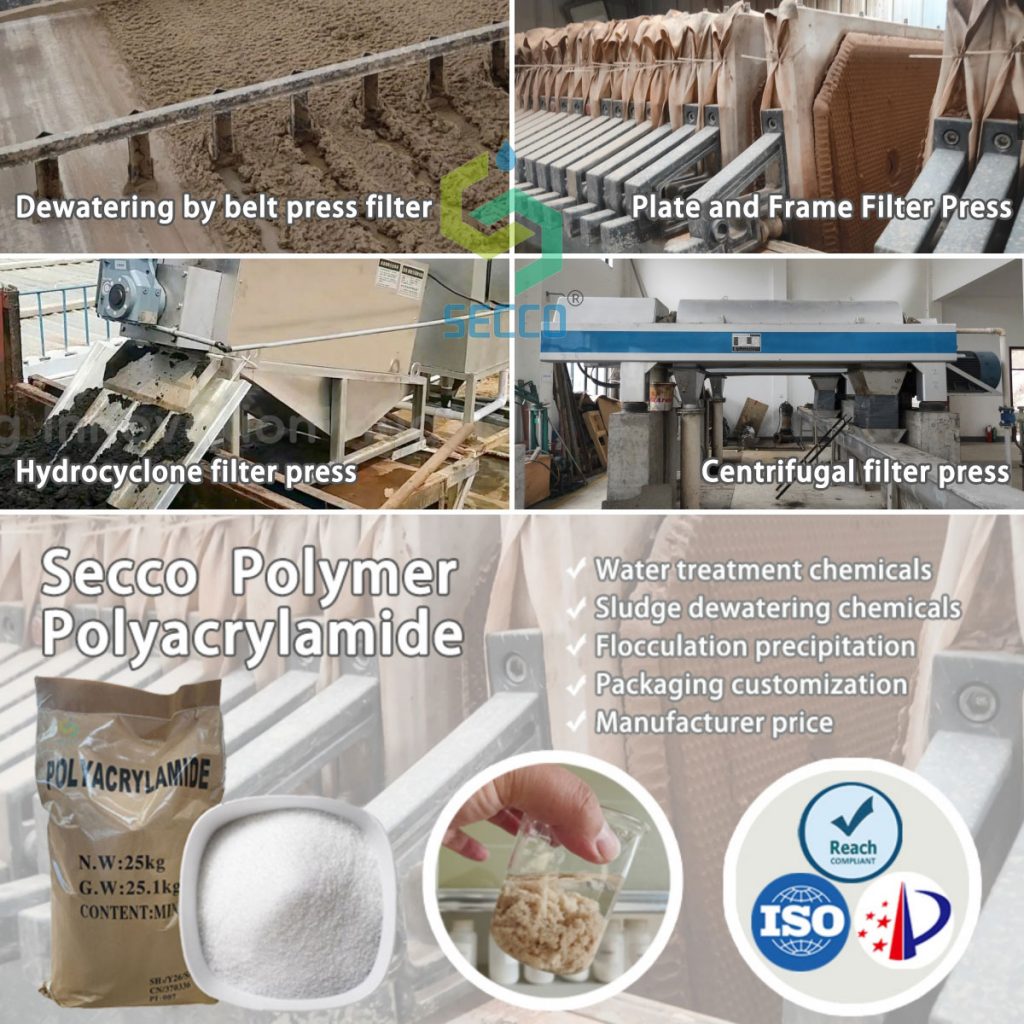Polyacrylamide (PAM) is a highly effective flocculant in sludge dewatering, significantly improving dewatering efficiency. Its selection and application depend on sludge characteristics and the type of dewatering equipment used.

Below is a detailed analysis:
1. Performance of Polyacrylamide (PAM) in Sludge Dewatering
Mechanisms of Action
Charge Neutralization: Neutralizes the negative charges on sludge particles, reducing repulsion and promoting aggregation.
Adsorption Bridging: Long polymer chains form bridges between particles, creating larger and denser flocs.
Sweep Flocculation: PAM physically traps fine particles, enhancing sludge compressibility.
Key Influencing Factors
Sludge Type:
Organic sludge (e.g., municipal sludge) typically requires cationic PAM.
Inorganic sludge (e.g., industrial sludge) may use anionic or non-ionic PAM.
Molecular Weight (MW):
High MW (8–15 million) for belt presses & centrifuges.
Medium MW (5–10 million) for screw presses.
Low MW (3–8 million) for plate & frame presses.
Ionicity (for Cationic PAM):
Low ionicity (10–30%): Weakly charged sludge.
Medium ionicity (30–50%): Common for municipal sludge.
High ionicity (50–60%): High-solid or industrial sludge.
2. PAM Selection for Different Filter Presses
(1) Belt Filter Press
Equipment Features: Continuous operation, relies on gravity drainage and mechanical squeezing.
PAM Requirements:
Type: Medium-to-high ionicity cationic PAM (30–50%).
MW: 8–15 million (forms strong, shear-resistant flocs).
Function:
Enhances sludge settling in the gravity zone.
Improves cake formation under pressure.
(2) Plate & Frame Filter Press
Equipment Features: High-pressure filtration, requires low-moisture sludge cake.
PAM Requirements:
Type: Low-to-medium ionicity cationic PAM (10–30%) or non-ionic PAM (for acidic sludge).
MW: 5–10 million (avoids filter cloth clogging).
Function:
Reduces filtrate turbidity.
Increases solid content in the cake (typically 70–80% DS).
(3) Screw Press (Dewatering Screw)
Equipment Features: Combines screw pressure and static/dynamic ring filtration; suitable for low-concentration sludge.
PAM Requirements:
Type: Medium ionicity cationic PAM (20–40%).
MW: 6–12 million (balances floc strength and dewatering speed).
Function:
Prevents fine particle leakage.
Reduces energy consumption.
(4) Centrifuge (Decanter Centrifuge)
Equipment Features: High-speed centrifugal force separates solids from liquids.
PAM Requirements:
Type: High ionicity cationic PAM (40–60%).
MW: 10–15 million (forms dense flocs resistant to shear).
Function:
Accelerates solid-liquid separation.
Reduces centrate turbidity.
3. Key Considerations for PAM Selection
Sludge Testing: Jar tests determine optimal PAM type and dosage (typically 0.2–0.6 kg/ton dry solids).
Dissolution & Dosing:
Prepare PAM solution at 0.1–0.3% concentration.
Avoid excessive stirring to prevent polymer degradation.
Cost Optimization:
Cationic PAM is more expensive; balance performance and cost.
4. Common Issues & Solutions
Problem Possible Cause Solution
Weak flocs Low PAM dosage or wrong type Increase dosage or switch to higher ionicity PAM
High filtrate turbidity PAM MW too low or sludge pH mismatch Adjust MW or check sludge chemistry
Filter cloth clogging PAM MW too high Use lower MW PAM or optimize dosing
Conclusion
Proper PAM selection can significantly enhance dewatering efficiency, reducing sludge moisture to 60–80% depending on the equipment. Pilot testing is recommended to determine the best PAM type and dosage for specific sludge and machinery.
Would you like additional details on specific sludge types (e.g., pharmaceutical, textile) or advanced polymer modifications?Please contact us at Henan Saike. We will provide you with sincere service at any time!